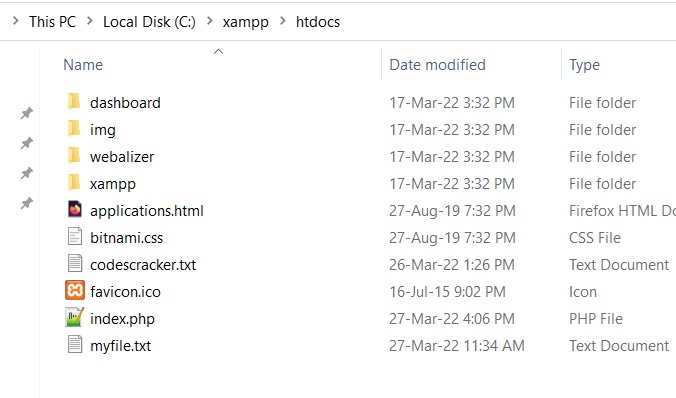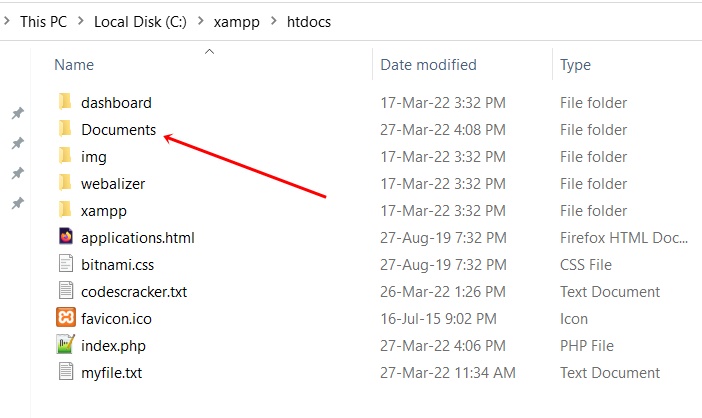- PHP Basics
- Learn PHP
- PHP Comments
- PHP Data Types
- PHP Variables
- PHP Operators
- PHP echo
- PHP print
- PHP echo vs. print
- PHP if else
- PHP switch
- PHP for Loop
- PHP while Loop
- PHP do...while Loop
- PHP foreach Loop
- PHP break and continue
- PHP exit()
- PHP exit() vs. break
- PHP isset()
- PHP Arrays
- PHP print_r()
- PHP unset()
- PHP Strings
- PHP Functions
- PHP File Handling
- PHP File Handling
- PHP Open File
- PHP Create a File
- PHP Write to File
- PHP Read File
- PHP feof()
- PHP fgetc()
- PHP fgets()
- PHP Close File
- PHP Delete File
- PHP Append to File
- PHP Copy File
- PHP file_get_contents()
- PHP file_put_contents()
- PHP file_exists()
- PHP filesize()
- PHP Rename File
- PHP fseek()
- PHP ftell()
- PHP rewind()
- PHP disk_free_space()
- PHP disk_total_space()
- PHP Create Directory
- PHP Remove Directory
- PHP Get Files/Directories
- PHP Get filename
- PHP Get Path
- PHP filemtime()
- PHP file()
- PHP include()
- PHP require()
- PHP include() vs. require()
- PHP mysqli Tutorial
- PHP mysqli Tutorial
- PHP and MySQL Setup
- PHP mysqli: Create Database
- PHP mysqli: Create Table
- PHP mysqli: Insert Record
- PHP mysqli: Update Record
- PHP mysqli: Fetch Record
- PHP mysqli: Delete Record
- PHP mysqli: SignUp Page
- PHP mysqli: LogIn Page
- PHP mysqli: Store User Data
- PHP mysqli Functions
- PHP mysqli_connect()
- PHP mysqli_close()
- PHP mysqli_connect_errno()
- PHP mysqli_connect_error()
- PHP mysqli_query()
- PHP mysqli_fetch_row()
- PHP mysqli_fetch_assoc()
- PHP mysqli_fetch_array()
- PHP mysqli_free_result()
- PHP mysqli_error()
- PHP mysqli_prepare()
- PHP mysqli_stmt_bind_param()
- PHP mysqli_stmt_execute()
- PHP mysqli_stmt_fetch()
- PHP mysqli_stmt_store_result()
- PHP mysqli_stmt_num_rows()
- PHP mysqli_stmt_bind_result()
- PHP mysqli_stmt_get_result()
- PHP mysqli_result class
- PHP mysqli_report()
- PHP error_reporting()
- PHP mysqli_real_escape_string()
- PHP htmlspecialchars()
- PHP Misc Topics
- PHP Object Oriented
- PHP new Keyword
- PHP header()
- PHP getallheaders()
- PHP Cookies
- PHP Sessions
- PHP Date and Time
- PHP GET vs. POST
- PHP File Upload
- PHP Image Processing
PHP mkdir(): Create a Directory
The PHP mkdir() function is used when we need to create a new directory. For example:
<?php
$dir = "Documents";
$chk = mkdir($dir);
if($chk)
echo "<p>A new directory is created</p>";
else
echo "<p>Unable to create</p>";
?>
Before executing the above PHP code, here is a snapshot of the current directory:

After executing the above PHP code or example, here is the output produced in the web browser:

And here is the new snapshot of the current directory after executing the above PHP code:

PHP mkdir() Syntax
The syntax of the mkdir() function in PHP is:
mkdir(directory, permissions, recursive, context)
The first (directory) parameter is required, whereas all the other three parameters are optional.
Note: The directory parameter is used to specify the directory to create.
Note: The permissions parameter is used to specify permission. The default value is 0777.
Note: The recursive parameter is used when we need to allow the creation of nested directories. The default value is false.
Note: The context parameter is used to specify the context resource. The default value is null.
The mkdir("xyz") is the same as mkdir("xyz", 0777, false, null).
Advantages of the mkdir() function in PHP
- mkdir() is a straightforward function that can create a new directory with a single line of code.
- mkdir() is a built-in PHP function that works on the vast majority of PHP-enabled servers, making it a dependable and portable way to create directories across platforms.
- If the directory was successfully created, mkdir() returns TRUE; otherwise, it returns FALSE. This enables you to handle errors and take appropriate actions based on the operation's success or failure.
- Because mkdir() can create directories recursively, you can create a new directory as well as all of its parent directories in a single call. When creating complex directory structures, this can save you time and effort.
Disadvantages of the mkdir() function in PHP
- Using mkdir() to create a new directory can cause permission problems if the user running the PHP script does not have the necessary permissions to create directories in the specified location.
- If an existing directory has the same name as the directory you're trying to create, mkdir() will overwrite it. If the existing directory contains important data, this can result in data loss.
- mkdir() only returns a Boolean value indicating success or failure and does not provide detailed error messages to assist you in diagnosing the cause of any errors that occur.
« Previous Tutorial Next Tutorial »